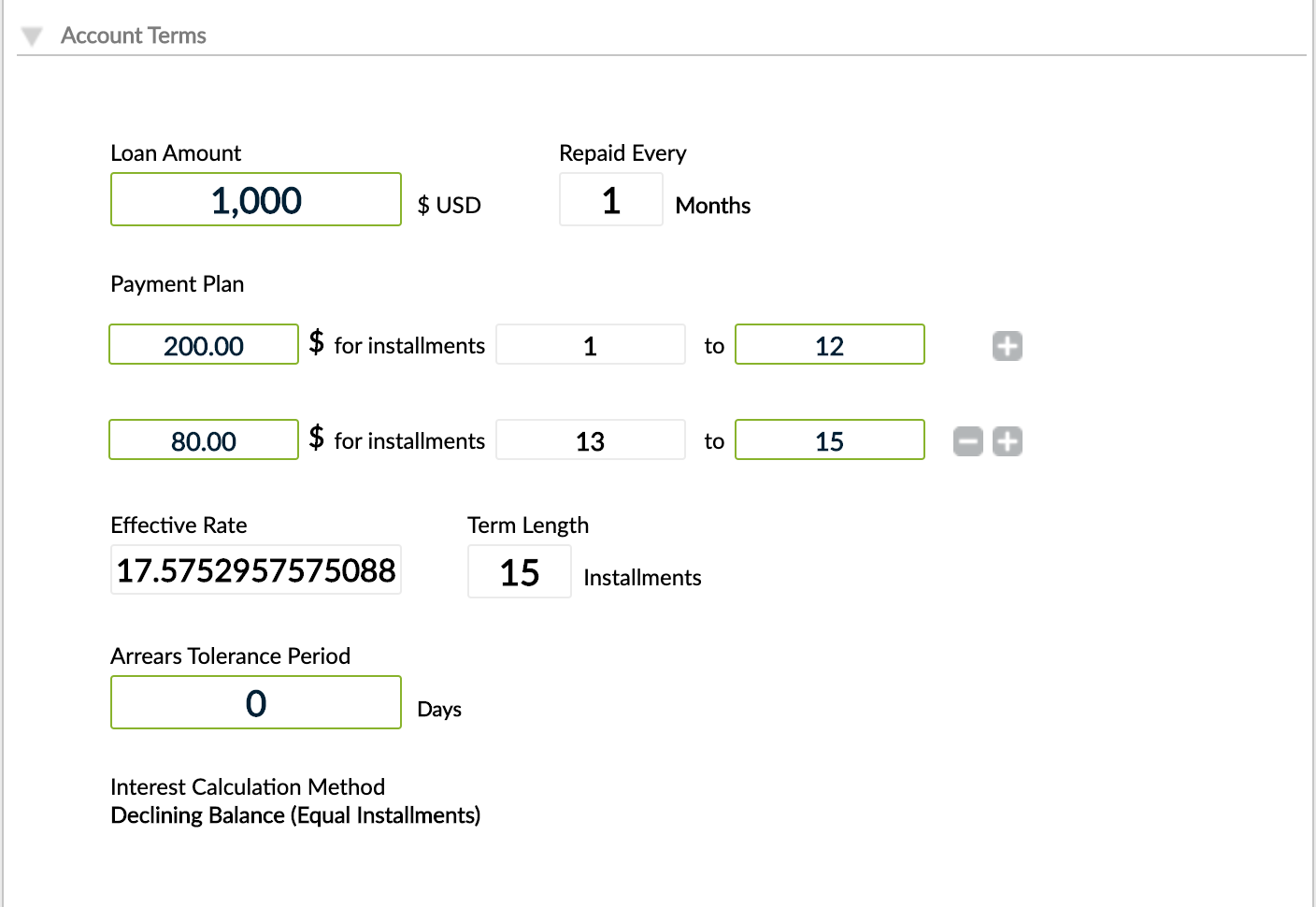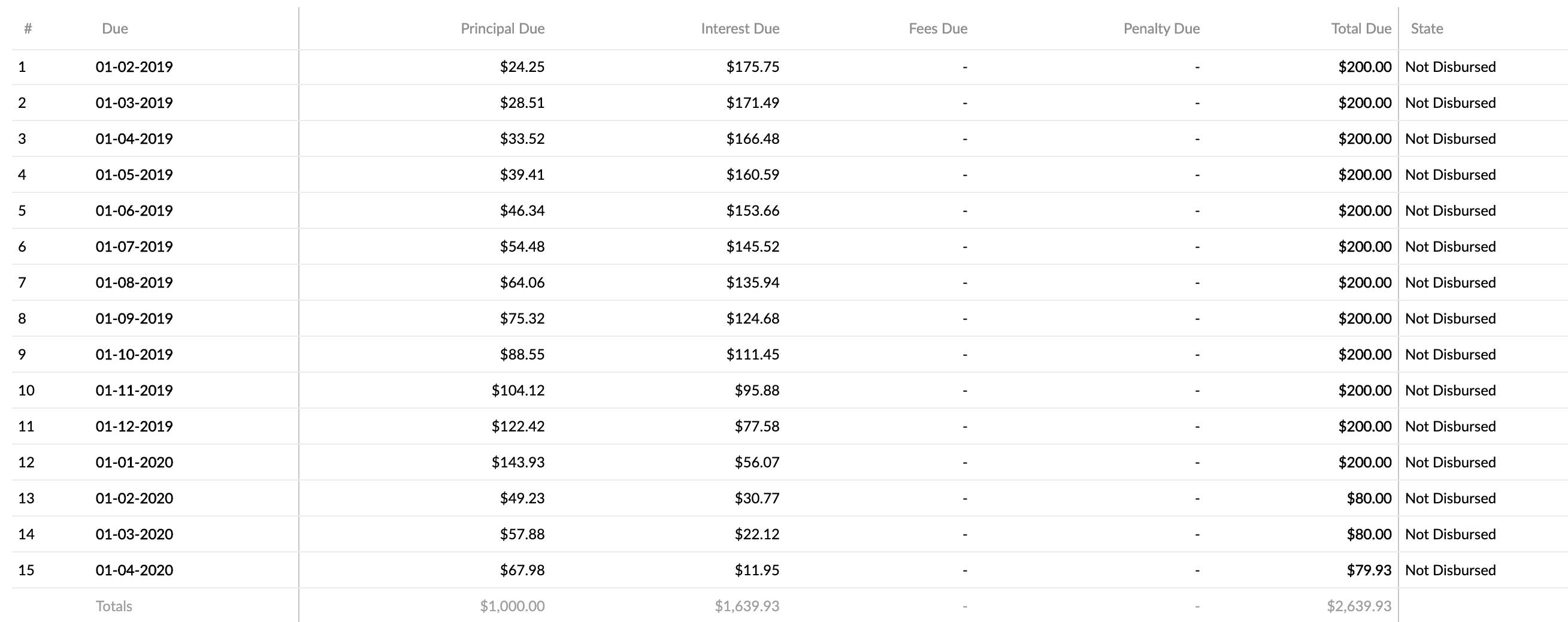- 16 May 2023
- 4 Minutes To Read
- Print
- DarkLight
- PDF
Payment Methods for Declining Balance Equal Installments (DBEI) Loans
- Updated On 16 May 2023
- 4 Minutes To Read
- Print
- DarkLight
- PDF
For both dynamic and fixed term loans you can choose a payment method based on a declining balance with the borrower paying the loan down in equal installments. This type of loan allows a few different payment methods, which will have an impact on the schedule.
To select a payment method for the declining balance equal installments loans:
- In the main dashboard, go to Administration > Products > Loans.
- In the bottom-right corner, select New Loan Product.
- In the Creating a new loan product form, go to the Repayment Scheduling section and, under Payment Method, choose one of the following methods, explained on this page.
- Standard Payments, available for both Fixed and Dynamic Term loan products.
- Balloon Payments, available for both Fixed and Dynamic Term loan products.
- Optimized Payments, available for both Fixed and Dynamic Term loan products
- Payment Plan, available for Fixed Term loan products.
- Aftering configuring the rest of the product, select Save Product.

Standard payments
The Standard Payment method allows you to simply divide the total amount due (including interest) by the number of installments to be made to pay down the loan. If it is not possible to divide cleanly and rounding has been enabled for this product, the last payment may be slightly smaller or larger than the previous installments by a few cents.
When rounding has not been enabled for the product and the principal cannot be cleanly divided, you will receive a warning, giving you the option of changing the amount or the number of installments to ensure the collection of the entire amount.
Example
In the following example, rounding has been enabled for the product and the last installment is slightly different than the rest of the installments.

In the following example, rounding has not been enabled for the product and the last installment is exactly the same as the rest of the installments.

Balloon Payments
The Balloon Payments method allows you to offer borrowers a fixed repayment amount each month with the balance of the loan to be paid off in the final installment - which could be a lot bigger. These kinds of loans are typically targeted at businesses as a large final payment to settle the loan may be beyond the reach of an individual client.
When you create a loan account based on this product you will be able to set the monthly payment amount and Mambu will calculate the schedule. For dynamic loans, the schedule, including the amount of the final payment will be recalculated based on any overpayments made by the borrower.
Examples
The following is an example showing balloon payment making interest-only payments and settling the whole loan with a large lump sum at the end.

The following is an example showing balloon payment schedule paying down interest and some of the principal with the final payment being around half of what was initially lent to the client.

Payment Plan
The Payment Plan method allows you to specify a periodic payment for a specific number of installments with rates being able to rise or fall with subsequent installments.
Example
For example, you can change the interest rate throughout the life of the loan.
- You can reduce the interest rate by 1.5% each year.
- You can have 10% interest rate for the first three months of the loan, and after this period decrease it to 8% and continue with this rate until the loan reaches maturity.
When you create a loan account, you define your payment plan, as in the following example.

The interest rate is computed based on the Internal Rate of Return (IRR) formula.
In the image below we have illustrated the schedule for the loan account defined in the example above.

Optimised Payments
The Optimised Payments method allows you to have a minimum deviation in the last installment when the first installment period is different than the rest of the repayment periods.
The optimised payments method runs multiple iterations to find the best Periodic Payment (PMT) or total due and to generate the optimum schedule with minimum deviation and maintain it on the lower side. The deviation occurs due to the rounding of the repayment currency.
The optimised payments method is applied when creating or activating a loan account and will be reapplied when any changes are made to the schedule due dates or the number of installments.
Example
In the following example with optimized payments, the last installment is only one cent smaller than the rest of the installments.
Loan amount: USD1000
Interest rate: 10%
Disbursement date: May 1, 2023
First repayment date: July 1, 2023

In this example, the first installment contains more interest because of the two month period between the disbursement date and the first repayment date.


